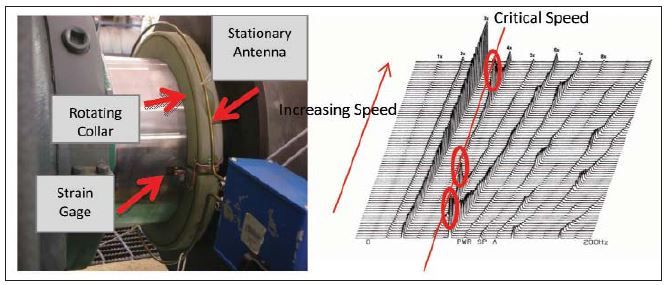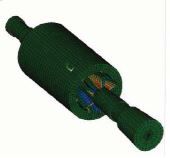Avoiding Torsional Failures in Induction Motors
HOW TO IMPROVE THE DAMAGE TOLERANCE OF COMPONENTS AS WELL AS TORSIONAL ANALYSIS PREDICTIONS
Torsional problems can be insidious in that they often go undetected with standard package instrumentation until a catastrophic failure occurs. Fundamentally, these failures are a result of interaction between the torsional critical speeds (natural frequencies) of the system and excitation energy produced by the drive system and load. In most cases, these issues are best resolved by shifting the critical speeds such that the offending excitation can no longer excite them. This is the primary goal of a torsional analysis during the design stage.
However, once a machine is built and put into service, the changes necessary to affect a significant shift in the critical speeds can sometimes be difficult and costly to implement. In addition, for some designs the required duty cycle will necessitate occasional excitation of torsional critical speeds, even when their placement has been optimized. Further, the rotating structural components of typical induction motors have the potential to aggravate torsional critical speeds and shaft stress behavior.
Figure 1: Torsional Telemetry System Components Figure 2: Excitation of a Torsional Critical Speed

In systems without a gearbox, the typically installed lateral shaft or casing vibration probes are not sensitive to torsional vibration. In most cases specialized instrumentation must be used to capture this type of data. One common method involves the use of a strain gage telemetry system, as shown in Figure 1. Several other methods of obtaining this data exist, including the use of a torsiograph or encoder on the outboard end of the motor or driven equipment.
However the data is obtained, the calculated torsional critical speeds can potentially be confirmed during startup or shutdown events, as depicted in Figure 2. In this illustration, a torsional critical speed is evident as it is traversed by relatively low-level energy generated at several orders of running speed.
This figure illustrates the concept that the train may need to tolerate some level of critical speed excitation during operations involving a speed change, even if the subject mode is not excited at nominal speed. In addition to common mechanical excitation sources (including the driven equipment), motors and variable frequency drives also produce excitation energy that can interact with the critical speeds.
The type of data shown in Figure 2 can be used to assess the damping present in the system (by observing the amplification factor of the response peaks). Additionally, dynamic torque or stress levels obtained from the test data can be compared to rotordynamic predictions.
Motor webs
Induction motor shaft webs serve several important functions, one of which is to provide a space for cooling air to flow between the rotor core and shafting. Although necessary, these features have the potential to contribute to common torsional stress related failures.

Figure 3: Typical Webbed Shaft Failure[/caption]
Figure 3 illustrates a typical torsional failure, in which a series of forty-fivedegree cracks are evident in the shafting and webs. In many cases, the cracks form at the base of the webs, and progress into the shafting itself.

Figure 4: Webbed Shaft Stress Distribution[/caption]
Figure 4 illustrates how the stress can intensify near the ends of the web bases, which is consistent with the failures shown in Figure 3. The initiation and propagation of these types of cracks can be significantly influenced by torsional resonances, excessive web flexibility, and stress concentration factors.
Special attention should be paid to the web-shaft interfaces to ensure that any necessary welds are properly dressed, and that the geometry is optimized in this area to diminish stress concentration effects, especially at each end of the webs.
If the webs in a motor design are sufficiently flexible, a resonance condition can occur as a result of the spring mass system comprised of the rotor core inertia, the web stiffness, and the base shafting. In some cases, this subsystem can exhibit a localized resonance that has the potential to interact with the torsional critical speeds of the system the motor is attached to.
This condition can further aggravate the stress levels developed at the web-shaft interface. In cases involving significant web flexibility, a finite element analysis (FEA) should be conducted in order to determine the effective stiffness of the webs, and it may be necessary to include additional elements in the torsional model to represent the webs (connecting the base shaft to the rotor core inertia) in order to properly account for this behavior. A similar treatment may be needed for cooling fans or other attached components that are flexible enough to interact with the torsional system.
It should also be noted that the web geometry attached to the base shafting can have a torsional stiffening effect. This phenomenon must be accounted for in order to properly calculate the torsional critical speeds. As an example of the possible magnitude of this effect, base shaft stiffening factors generally ran in a range of about 5% to 50% in representative 4 and 6 web geometries in a recent SwRI study. Figure 5 illustrates one analytical method (REF1) for determining the stiffening effect of the webs, or an FEA can be performed as an alternative.
At any significant diameter change (step) in the shafting, the potential exists for a large increase in localized stress concentration. For some designs, this can result in approximately twice the dynamic stress developed in the neighboring shafting. A generous fillet radius applied to these areas has the potential to greatly reduce the stress concentration factor. Peterson’s “Stress Concentration Factors” provides a good source of practical fillet radii for common ratios of shaft major and minor diameters, and the resulting stress concentration factors.
Stepped shafts at bearings
Figure 4 illustrates another common feature found in some induction motor designs that can complicate stress behavior. In cases where the shaft diameter is decreased significantly near the axial location of the drive end bearing, and then increased again to meet or exceed the shaft diameter inboard of the bearing, the shaft stress levels developed can increase dramatically.
The reason for this diameter change is usually attributed to optimizing the shaft surface speed within a given bearing design to accommodate the anticipated operating speeds. As a means of illustrating the potential torsional stress implications of such a change, a 0.5” reduction in a nominal 5” diameter shaft can result in a 37% increase in torsional stress.
A stepped shaft at a bearing can also result in two additional locations which require appropriate fillet radii in order to avoid significant stress concentration. From a torsional stress perspective, it is prudent to avoid a reduction of shaft diameter to accommodate a smaller drive end bearing whenever practical. It is also generally beneficial to maintain a minimum output shaft diameter of at least the coupling hub penetration diameter.
Interference fits are preferred from a torsional perspective at couplings and any other features requiring a hub. Although keyways may facilitate less complicated maintenance procedures in some applications, they have the potential to greatly magnify the dynamic stress experienced by the shafting, reaching a level of about three times the unintensified stress in typical geometries.
In some applications, the torque carrying capacities of the interference fits are insufficient to carry the desired load. In cases where keyways are an absolute necessity, a generous fillet radius should be applied to the bottom of the keyseat to reduce the stress concentration factor to tolerable levels. ASME/ANSI Standard B17.1, Keys and Keyseat, provides one source of practical guidelines for recommended keyseat fillet radii.
Occasionally, the best efforts to optimize the torsional critical speeds and stress concentration factors of a given machine still result in excessive calculated shaft stress levels. In these cases, the possibility of applying additional heat treatments to the base shaft material to increase the ultimate tensile strength (UTS) should be investigated.
An alternate base shaft material may also be used to increase the UTS if appropriate. For the steels routinely used to produce modern motor shafts, UTS values over a range of about 90ksi to 130ksi are common, depending on the specific material involved and the heat treatments applied. This range represents a maximum potential increase of about 44% in allowable shaft stress, which can greatly improve the damage tolerance of the machine. Many manufacturers can offer the option of additional heat treatments or an alternate base shaft material during the design process, if deemed necessary for a particular application.
Induction motor rotating structures can be optimized to improve long term reliability by avoiding common failure scenarios. These structural optimizations complement the benefits of a torsional analysis, (which seeks to optimize the frequency of the predicted critical speeds), by improving the ability of the components to tolerate anticipated stress levels.
Special attention should be paid to the motor web-shaft interface areas of induction motors to ensure that the welds are dressed properly, and that the remainder of the geometry avoids significant stress concentration. The stiffening effect of the web geometry on the base shafting should also be appropriately accounted for in the torsional model to ensure accurate critical speed predictions.
In cases involving significant web and cooling fan flexibility, the potential for localized resonances should be assessed with FEA, and the torsional model should be expanded to include the spring mass systems associated with these components if necessary.
Significant decreases in the diameter of the motor output shaft (in order to accommodate a smaller bearing) should be avoided if possible. Generous fillet radii should be applied to all diameter changes.
Keyways should only be used as a last resort, and if a keyway is absolutely necessary a generous fillet radius is recommended at the bottom of the keyseat to reduce stress concentration to tolerable levels. If these methods fail to produce acceptable calculated stress behavior, an increase in base shaft material UTS should be considered, through the application of additional heat treatments or utilization of an alternate material.